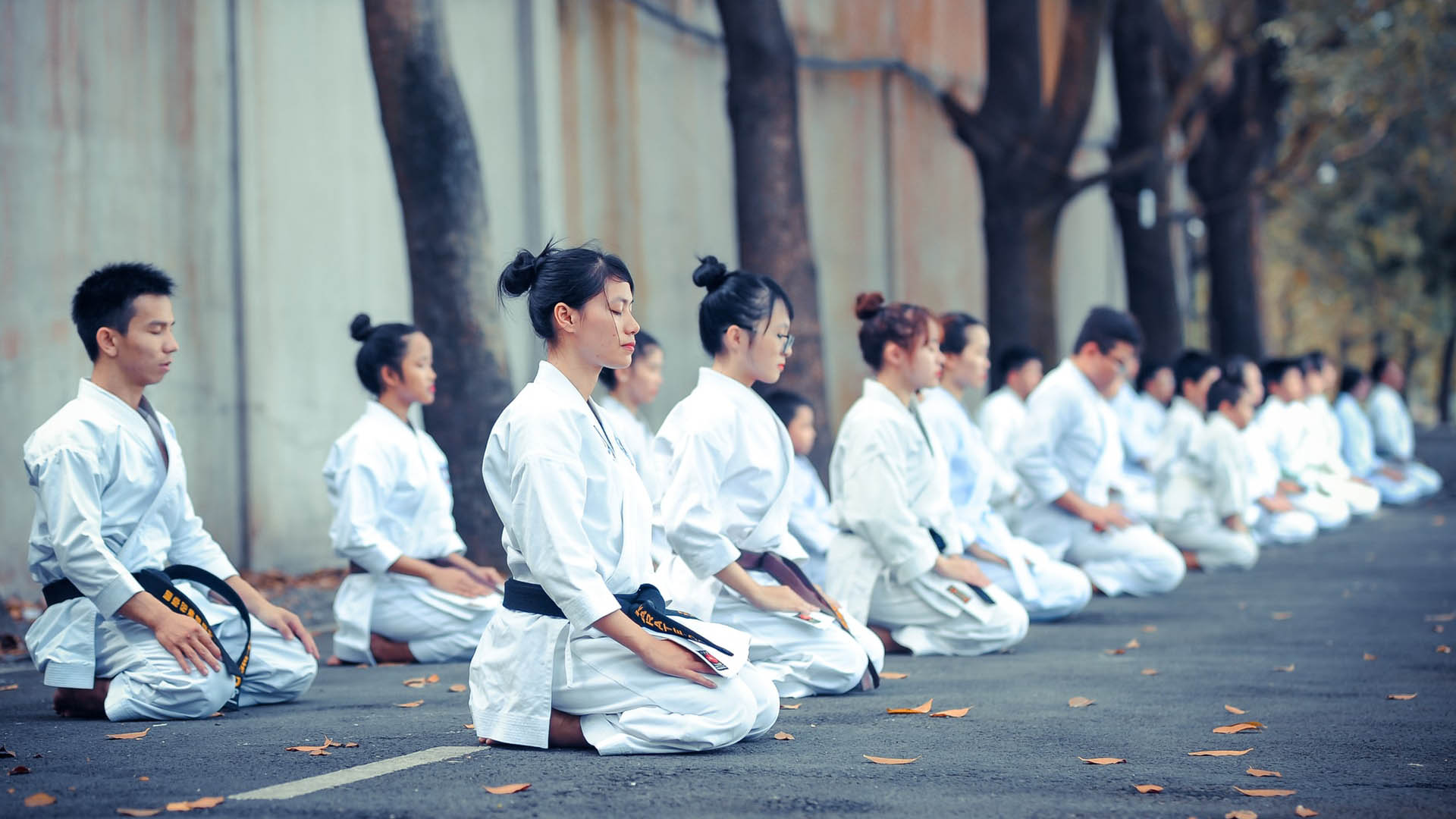Affiliate disclosure: Some of the links below are affiliate links, meaning, at no additional cost to you, I will earn a commission if you click through and make a purchase. As an Amazon Associate I earn from qualifying purchases.
Meditation myths and misconceptions
With 5,000+ years in its history, meditation comes in many forms. Many cultures, traditions, and religions have come up with different styles and techniques. Additionally, the diversity of people in characters, personalities, psychological makeup, and upbringings, etc. also play a role in adding to the varieties.
Therefore, we know there are Buddhist meditation, Hindu (Vedic and Yogic) meditation, Christian meditation, Sufi, Taoist, Qigong just to name a few. To go even further, Buddhist meditation has many styles and so as Vedic and Yogic.
And, those are only the more “traditional” style of meditations. Nowadays, we also encounter the more modern and non-sectarian types of meditation with their own unique branding.
With all that in mind, it will be trickier to define what meditation is.
It will be easier and more straightforward to talk about what meditation is NOT.
In daily conversations, still, I often find a lot of people are holding myths and misconceptions about meditation. And, this fact seems to hold them back from adopting meditation in their daily routine.
So, if you’re still hesitating and finding it hard to incorporate meditation into your lifestyle, this post is for you.
If you want to find the right meditation technique or style that will best suit you, I encourage you to check this course.
This article is based on my meditation background, my-own practice and things I can verify.
Though I find Vipassana (with its religious elements stripped off) arguably and practically universal, still, I’m aware that other traditions may have their own distinct and unique conceptions about what meditation is and is not.
So, in case if you’re from other traditions and are not in agreement with the points I laid out here, please, care to correct me in the comment 🙏.
Without further ado, let’s start.
Table of Contents
1. Meditation is all about relaxation

Incorrect. Meditation involves relaxation indeed. But, it’s only a small part, a basic part.
One way to put it, meditation is about recognizing and learning the workings of the mind. We do that by simply being aware of what’s happening in the mind with the right attitude and maintaining that awareness as continuously as possible.
Check out the right attitude for meditation.
In doing so, a certain level of relaxation is indeed needed. If you’re overly stressed and agitated, you will find it hard to be mindful so it will be difficult to meditate.
When you do relaxation, you’ll get relaxed. That’s it. But, the root cause that makes you need relaxing in the first place is still untouched. Meditation goes deeper than mere relaxation and, when practiced right, in due time, can uproot that cause.
Relaxation is NOT the goal of meditation. It’s only the beginning.
So, saying that meditation is all about relaxation cannot be further from the truth.
2. Meditation is only for monks and those walking the spiritual path
I think this one is the most outdated misconception.
It is true that in ancient times, meditators are usually monks and nuns of some sort. They wore distinct robes so that they’re easily recognized as spiritualists.
As time progress, prominent layman meditation masters emerged like S.N. Goenka and Sayagyi U Ba Khin.
In recent days, many famous meditation teachers like Jack Kornfield, Joseph Goldstein, and Sharon Salzberg are not monks or nuns.
Nowadays, many athletes, businessmen, scientists, artists, musicians, students, and practically, professionals in any field practice meditation because of its real benefits.

3. Meditation will make you abandon your life and become a monk
This is like saying going to the gym will make you a bodybuilder or taking a swimming course will make you a professional swimmer.
In all likelihood, there are more people, living normal lives, who meditate than monks and nuns living in monasteries who meditate.
4. Meditation is not Christian
I came across people with this view several times. Some of them are my friends. They told me that their churches forbid and discourage meditation.
Try googling with the keyword “Christian meditation”, and you’ll get more than 130+ million results.
So, I don’t think this is a general conviction.
The Catholics have been practicing meditation for centuries. They have monks and nuns living in monasteries and hermitages who dedicate their lives to meditation.
They even have words for it like contemplation and devotion. They use certain holy figures as the focus of devotion. They also use prayers with the emphasis on love and compassion.
Some other church denominations have similar recollection sessions which are done in groups regularly.
So, the terms being used may be different, the objects may be unique, but the technique? Yes, that’s meditation.
So, are the Catholics considered not Christian?
Are simply being aware of your prayers, your thoughts, your feelings, your inner voices considered not Christian?
Are the practice of focusing on loving-kindness and compassion considered not Christian?
You decide.
5. Meditation is about quieting or emptying the mind
The word quieting and emptying imply an active kind of effort. Meditation is simply being aware of what’s happening in the mind with the right attitude and maintaining that awareness as continuously as possible. So, it’s a more passive kind of effort.
Forcing the mind to be quiet is not the right attitude in meditation. You’ll find that your mind won’t do your bidding willingly. And, by forcing the mind, you position it as your enemy. This is, definitely NOT meditation.

Furthermore, you certainly cannot empty the mind. Although in your practices, at times, you’ll find there are no thoughts, no memories, no feelings arise, that doesn’t mean that the mind is empty. It just means that the mind is entering a neutral state or equanimity. And, that state won’t last forever. In time, the mind will get out of that state.
6. You need a quiet mind to meditate
This is like saying, “you need to be fit to go to the gym.”
You don’t need a quiet or calm mind to meditate. In fact, if your mind is noisy or agitated, it means that you now have even more reasons to meditate.
Generally speaking, nobody has a really quiet mind. Maybe, the only exceptions are the monks living in seclusion who dedicate their entire lives to meditation.
That’s why, in all likelihood, everybody needs to meditate.
7. Meditation is all about concentration
There are indeed many techniques and traditions that put a heavy emphasis on concentration. The word focus and focusing are also often used as substitutes.
The Buddhist’s Samatha style of practice with its 40 meditation objects is a good example of this. In this style of practice, you train to focus your mind on a single object to achieve one-pointedness. This way, you calm your mind in the process. If your goal is to achieve tranquillity or calmness, this technique is an effective way to go.
The Buddhist’s Vipassana (insight or mindfulness) meditation, on the other hand, puts more emphasis on the continuity of awareness of the true nature of reality to gain clarity and understanding. In turn, this understanding or insight liberates us from delusion.
To practice vipassana, some degree of concentration is required. This is why some teachers promote samatha practice as a precursor to vipassana.
But, in vipassana, concentration doesn’t necessarily mean one-pointedness. Stability of mind is probably the more suitable term. To be mindful, to observe what’s happening and what has stopped happening in the mind, the mind needs to be stable enough without too much wavering or wandering away.
And, focusing is not the only way to achieve this stability. Stability of mind can also be achieved by maintaining awareness continuously.
Some other techniques completely disregard concentration.
So, with the above examples, it’s enough to say that meditation is NOT all about concentration.
8. Meditation is selfish
It’s true that meditation is usually practiced alone by sitting still with no perceptible benefits for others. One can easily conclude that meditation is a selfish act.
But, if we dig deeper, one of the goals of meditation is to purify the mind. And, the mind is the root of all our deeds which are our thoughts, our speeches, and, our physical actions. It is through our thoughts, our speeches and our physical actions that often we hurt others either consciously or unconsciously.
The bottom line is, all evils or unwholesomeness begin in the mind.
With that in mind, then, purifying the mind from all these unwholesome roots is the most SELFLESS thing a man can do!
But, is it true that too much mindfulness may increase selfishness?
9. Meditation will make you insensitive
Meditation will make you less impulsive, less reactive, in a good way. Meaning, it will make you less of a slave of your feelings because you’ll be more mindful of them.
Meditation won’t reduce your capacity to feel or to empathize in any way. In fact, through your practice, you’ll gain more clarity and understanding of what’s going on, thus you’ll react more properly with total awareness.
Meditation will make you less-emotional but more mindful. It definitely won’t make you emotionless or insensitive.
10. Meditation is running away from reality

If we see meditation as observing our own mind, to be aware of it and to be fully mindful of it to gain clarity and understanding, then, meditation is running DIRECTLY INTO the roots of reality.
There are many aspects in our mind that we’re trying to burry deeply and that we don’t want others to know.
Meditation is the practice to face this reality in its core with the right attitude and accept it as it is.
11. You must sit still, cross-legged, like a statue
No, sitting is only one of the meditation postures. The other postures are walking, lying down, standing and, daily activity.
Of course, the formal sitting posture is usually the more popular one and the one we encounter a lot. But you don’t have to sit on a cushion in the lotus position if you’re not flexible enough. You can always use a chair.
As you progress, when you’ve developed some clarity and understanding, then what? You continue your practice in your daily activities. Think of it as changing your meditation posture.
12. You have to close your eyes to meditate

Meditation can be done with the eyes closed, open, half-closed; it’s your choice.
Many practitioners, especially beginners find it difficult to meditate with their eyes closed.
Two things are usually the hindrances. The mind will easily wander away with the eyes closed. Or, drowsiness easily creeps in.
This is why some techniques use physical objects like candlelight, flowers, figures or statues as meditation objects. Those will require the meditators to practice with their eyes open. This approach can help practitioners to build and maintain alertness and stability.
Walking meditation is certainly done with open eyes and so is the daily-activity posture.
13. Meditation is very hard
Meditation is certainly not the easiest thing to do in the world. But, very hard? Not really.
Usually, this statement is only an excuse for not practicing.
If you find it hard to meditate, chances are, you are not using the right technique. When I say the right technique, I mean the right technique FOR YOU.
Or, if on occasions, you feel a lack of interest and motivation, you can take advantage of these effective meditation hacks.
You can also learn these 4 tiny steps to achieve your goals without relying on motivation.
14. Meditation is dangerous, you can go insane

Everything is dangerous. Cross the street, you may get hit by a car. Turn on the light, you can get electrocuted. Play tennis, you may injure your elbow. Even walk slowly on the sidewalk, you may accidentally step on a banana peel and slip.
But, because of the dangers involved, does it mean we shouldn’t do any of those things? No, of course, it doesn’t!
Meditate, and you may probably face various nasty and traumatic memories from your past and also, all the things you’ve been suppressing; the things you don’t want other people to know. And, if it happens when you’re not ready or prepared, it will scare the hell out or you.
Yet, people have been practicing meditation for thousands of years. Why do people still meditate?
Because it’s highly profitable. It outweighs the danger, by a very large margin.
All meditators will have to go through that “dark night” at some point. But, with the right technique, a gentle approach, and the right attitude, you can get through it.
Meditation is the practice to develop awareness. That, in itself, is not dangerous. On the contrary, increased awareness will protect you against dangers.
The key here is to take it slowly, be gentle. Meditation is a gradual process. Work on your foundation patiently using a neutral object (your breath is usually the best). Don’t rush to the next state! This way, you’ll progress at a natural pace.
At this point, a qualified teacher is very important.
15. One meditates to acquire psychic powers

The fact is, many people meditate for practical reasons other than having psychic powers. Having psychic powers usually is more of a distraction rather than an indicator of progress.
Although, theoretically, gaining psychic powers through meditation is possible but it’s an extremely rare occasion, even if you’re seeking them intentionally. So, it should not be your goal.
If by any chance, you do get ones, it’s best to not give them any importance and don’t play with them. But, you also don’t need to get rid of them. Without clinging to them and without rejecting them, you exercise the right attitude.
The best advice at this point is, go back to your practice.
16. It will take years to experience any benefits
Many studies have shown that meditation can bring significant physical and mental benefits even only after 8 weeks of practice. You can learn more about them in this post: Practical Reasons to Meditate for Lazy People.
The truth is, the effects of meditation are IMMEDIATE. If you pay enough attention, after each formal sitting or walking session, you can feel calmer, more focused, more relaxed and more balanced. The effects may be subtle, but they’re real.
If what you seek is better health, more peace, more balanced, you’ll experience it within a few weeks.
But, if your goal is to attain enlightenment, then, of course, it will take a while.
Conclusion
I hope I’ve covered the most important meditation myths and misconceptions and have helped clear a few things up.
The points I outlined above are essentially what meditation is not. Those myths and misconceptions about meditation, though fairly common, yet, still surprise me.
If there are other points that I may have overlooked and that you think should have been included in this post, please, feel free to suggest them in the comment.
As you can see, regardless of its historical backgrounds, meditation is pretty much universal. It doesn’t have to be associated with any religions or traditions.
Practiced the right way, with the right technique, it will bring many-fold deep lasting benefits to everyone.
For a simple mindfulness meditation guide, you can download my free guide here.
Want to explore deeper and find the most suitable meditation technique for you? I highly encourage you to check this course.
You can read my full review here.
Related posts
- 10 Ways Meditation Can Help Improve Your Finance (Number 9 Might Surprise You!)
- The Best Thing Meditators Can Do During the Coronavirus COVID-19 Outbreak
- Smart Ways to Eliminate All Hindrances to Improve Your Meditation Practice
- Who Can Really Help You Stop the Fear of Panic Attacks?
- My Recent Posts
Featured image designed by katemangostar / Freepik
- Too Much Mindfulness, Is There Such a Thing? - March 17, 2022
- 10 Ways Meditation Can Help Improve Your Finance (Number 9 Might Surprise You!) - January 7, 2022
- Forget Self-Improvement, Do This Instead! - September 16, 2021

